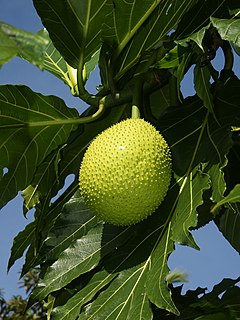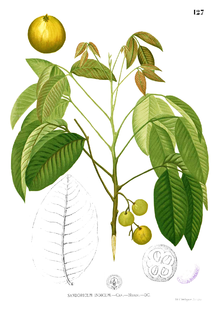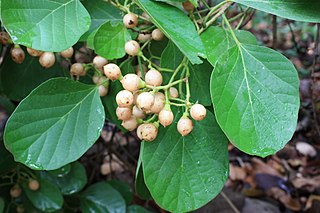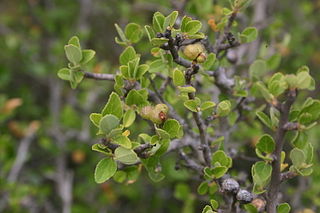
Breadfruit is a species of flowering tree in the mulberry and jackfruit family (Moraceae) believed to be a domesticated descendant of Artocarpus camansi originating in New Guinea, the Maluku Islands, and the Philippines. It was initially spread to Oceania via the Austronesian expansion. It was further spread to other tropical regions of the world during the Colonial Era. British and French navigators introduced a few Polynesian seedless varieties to Caribbean islands during the late 18th century. Today it is grown in some 90 countries throughout South and Southeast Asia, the Pacific Ocean, the Caribbean, Central America and Africa. Its name is derived from the texture of the moderately ripe fruit when cooked, similar to freshly baked bread and having a potato-like flavor.

The jackfruit, also known as jack tree, is a species of tree in the fig, mulberry, and breadfruit family (Moraceae). Its origin is in the region between the Western Ghats of southern India, all of Bangladesh, Sri Lanka and the rainforests of the Philippines, Indonesia, and Malaysia.

Dovyalis caffra (Warb.), Aberia caffra the Umkokola, Kei apple, Kayaba, Kai apple, or Kau apple, is a small to medium-sized tree, native to southern Africa. Its distribution extends from the Kei River in the south, from which the common name derives, northwards along the eastern side of the continent to Tanzania. The ripe fruits are tasty, reminiscent of a small apple.

Hyphaene thebaica, with common names doum palm and gingerbread tree, is a type of palm tree with edible oval fruit. It is a native to the Arabian Peninsula and also to the northern half and western part of Africa where it is widely distributed and tends to grow in places where groundwater is present.

Carissa is a genus of shrubs or small trees native to tropical and subtropical regions of Africa, Australia and Asia. Until recently about 100 species were listed, but most of them have been relegated to the status of synonyms or assigned to other genera, such as Acokanthera.

Ziziphus mauritiana, also known as Indian jujube, Indian plum, Chinese date, Chinese apple, and dunks is a tropical fruit tree species belonging to the family Rhamnaceae. It is often confused with the closely related Chinese jujube, but whereas Z. jujuba prefers temperate climates, Z. mauritiana is tropical to subtropical.

Spondias purpura is a species of flowering plant in the cashew family, Anacardiaceae, that is native to tropical regions of the Americas, from Mexico to Brazil. It is also very common in most of the Caribbean islands. It is commonly known as jocote, which derives from the Nahuatl word xocotl, meaning any kind of sour or acidic fruit. Other common names include red mombin, plum, purple mombin, hog plum, ciriguela, ceriguela, seriguela, siriguela (Brazil) cocota, ciruela huesito (Colombia), ciruela, ciruela traqueadora (Panama), ciriguela, cirigüela, cirguela, cirguelo (Ecuador), makapruim, and siniguelas (Philippines). It is a popular fruit throughout Central America, particularly in El Salvador, Nicaragua, Honduras and in Costa Rica.

Sandoricum koetjape, the santol, sentul or cotton fruit, is a tropical fruit native to maritime Southeast Asia (Malesia).

Capparis decidua, commonly known as karira, is a useful plant in its marginal habitat.

Cordia myxa, the Assyrian plum, is a mid-sized, deciduous tree in the borage family (Boraginaceae), native to Asia. It produces small, edible fruit and is found in warmer areas across Africa and Asia. Other common names include lasura, laveda, pidar, panugeri, naruvilli, geduri, spistan, burgund dulu wanan and ntege.

Balanites aegyptiaca is a species of tree, classified as a member of either the Zygophyllaceae or the Balanitaceae. This tree is native to much of Africa and parts of the Middle East.

Flacourtia indica, known commonly as ramontchi, governor's plum, Madagascar plum and Indian plum, is a species of flowering plant native to much of Africa and tropical and temperate parts of Asia. F. indica and F. ramontchi are sometimes treated as separate species.

Treculia africana is a tree species in the genus Treculia which can be used as a food plant and for various other traditional uses. The fruits are hard and fibrous, can be the size of a volleyball and weight up to 8.5 kg (19 lb). Chimpanzees have been observed to use tools to break the fruits into small pieces that they can eat. The fruits contain polyphenols.

Cordia sinensis is a species of flowering tree in the borage family, Boraginaceae. The species’ range extend from South Africa, through East Africa, Madagascar, West Africa and the Middle East to the Indian Subcontinent and Eastern Indochina. There is also a disjunct native population in Senegal. The species has become naturalised in Eastern Australia. Common names include grey-leaved saucer berry, grey-leaved cordia, marer, mnya mate, mkamasi and tadana.

Ximenia caffra, the sourplum, is a small tree or small shrub that is thinly branched. It is part of the Olacaceae family which is native throughout tropical regions. In particular, the sourplum is native to regions in South East Africa, mainly Botswana, Kenya, Malawi, Mozambique, South Africa, Tanzania, Uganda, Zambia, and Zimbabwe. The sourplum tree produces several fruits on an annual basis. These are generally sour with a dry aftertaste, and they contain significant amounts of potassium. The tree itself is fairly hardy, with frost resistance and drought tolerance. The tree, fruit, seed, leaves, and roots are all used for human consumption, medicinally, or for fuel. The trees themselves can also be used as natural land division barriers.

Grewia robusta is a multi-stemmed shrub or small tree, up to 3 m high, endemic to the semi-desert Karoo of South Africa, and very similar to Grewia occidentalis. It is one of some 325 species of Grewia in the family Malvaceae, and having a tropical African, Asian and Australian distribution. It is found in the arid regions of the Karoo and Eastern Cape, and generally prefers growing among dry scrub on rocky hillsides.
Balanites glabra is a species of tree or shrub, classified either as a member of the Zygophyllaceae or the Balanitaceae. This tree is native to East Africa.
Balanites wilsoniana is a species of fruit-bearing tree from west and central Africa from the caltrop family (Zygophyllaceae).
Balanites angolensis, or Angolan green-thorn, is a species of tree from southern Africa, it is a member of the caltrop family, Zygophyllaceae.
Balanites pedicellaris, the small green-thorn or small torchwood is a small tree or shrub from Sub-Saharan Africa. It is a member of the caltrop family Zygophyllaceae.















